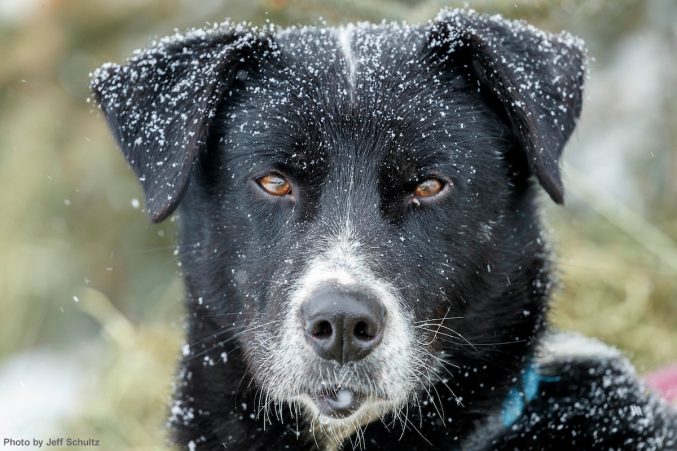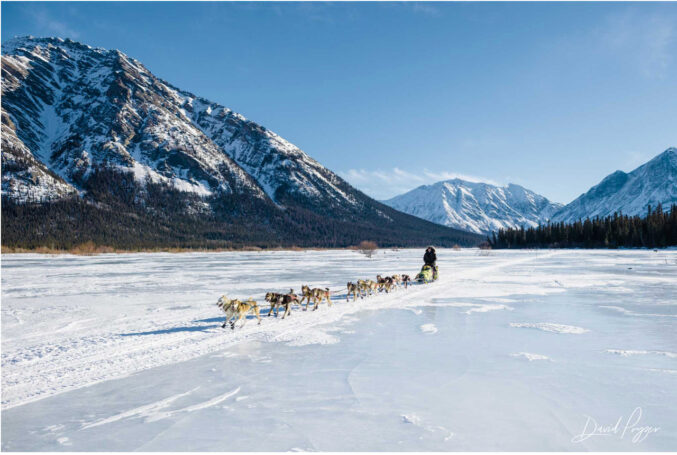What do you picture when you think about the Iditarod? If you have never seen this amazing event in person, you rely on photos and videos taken by others. Spectators who have experienced the Last Great Race might show you their snapshots of a dogsled traveling over sparkling snow, the fur on the dogs’ bodies thick and soft. Perhaps there is a halo of snowfall around the scene. Maybe the sun cuts glaringly across the sled at an angle, lighting up the colors. This month’s lesson plan will help you and your students learn how to study Iditarod photography. You can help your students become better artists and better at noticing all kinds of things.
You may peruse a set of Iditarod photographs and stop one image that stands out to you. Your eyes, mind, and heart linger on it, studying the elements and appreciating how it conveys a certain message. There is a reason for this: the artist has purposefully combined elements of formal analysis to create meaning for us, the viewer. Here are two examples from Iditarod Media:
- Gerhardt Thiart on the Trail to Nikolai (Photo: David Poyzer)
- Guy Blankenship’s Team Heads Down Trail Iditarod AK / Under trail view 1989
As you look at these images, you should take note of lines, shapes, colors, the arrangement of things in the image, and other elements. Noticing and naming these elements is called formal analysis. I remember class after class in my grad school days, looking at works by artists from all periods of art history, naming formal elements, determining the focal point, talking about color, contrast, shadow, balance, and composition. It is still so fun because these elements add up to a powerful, memorable, and meaningful image through which we can discern deeper truths.
In this lesson, you and your students can identify the elements of art in the work of Iditarod photographers, just as you can with great artists of the past. The formal language of art has not changed. We get to experience the race through Iditarod photography. For example, we understand the contrast of power and softness in the dogs, textures of snow, outdoor gear, trees, and structures, and many more features of the Iditarod. Your eye can follow a curving path through the trees and sense the motion of sleds as they disappear toward the horizon.

A returned dog from the Charlie Bejna team waits at the Rainy Pass checkpoint on Puntilla Lake during the 2019 Iditarod on Tuesday, March 5th, 2019.
Photo by Jeff Schultz/ (C) 2019 ALL RIGHTS RESERVED
Through the perspective of formal analysis, you and your students can understand the messages of the photographs and the artists in a deeper way. I encourage you to examine your own pictures for this hidden language of art. “But it’s just a snapshot!” you might think. Even snapshots have the power to convey rich meaning. Naming these elements gives us a common language to experience and learn about the Iditarod in a new way.
This lesson will encourage you and your students to think about formal analysis in many situations. I’ve included images for you to study from Iditarod photographers Jeff Schulz, Dave Poyzer, and Siri Raitto, who have been working with Iditarod for many years and have graciously given permission for me to use their works for this lesson. There are many more amazing images on their web sites. Maybe you too have some images from the Iditarod you treasure.

A snapshot of vet checks at Iditarod Headquarters, 2023. Photo: K. Newmyer
The lesson also encourages students to create their own artworks inspired by their favorite Iditarod images, being intentional about using the elements of art. You can use this lesson for social & emotional learning for self-discovery by asking what images do I like the best, and why; and also, what images do I not prefer, and why? This lesson even has cross-curricular applications to language arts, science, math, and geography.
I hope you love this Iditarod art lesson as much as I do. Share with me what you discover. Email me at emailtheteacher@iditarod.com.




